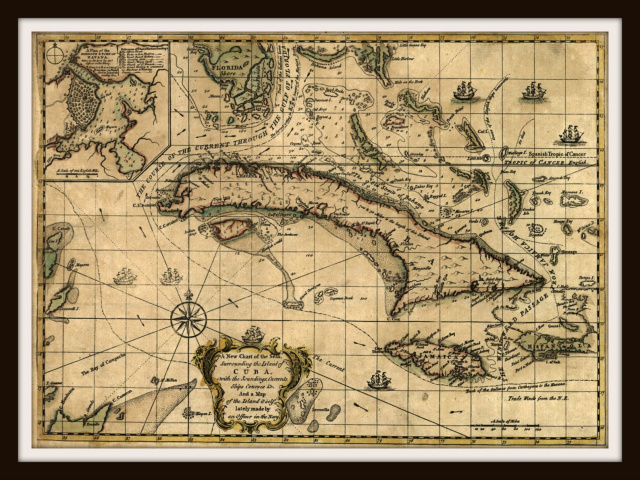C. 1807 Cuban Waters Wreck 8 Reale Spanish Shipwreck Coin, Carolous IV NGC Certified
Price: $850.00
Availability: in stock
Prod. Code: Shipwreck Buried Treasure
Cuban Waters Spanish Shipwreck Coins
A few very rare 8 Reales Shipwreck silver coins from the island waters of Cuba were located, preserved and authenticated. These coins are dated prior to 1807 . They bear the mintages of Mexico City, New Guatemala, Bolivia, and Lima.
The NGC certification serves to authenticate that this a true discovery from Cuban waters. This is one of the rare and few coins verified and authenticated as an incredible piece of Spanish/American history.
These pieces were very likely on their way to the central east coast of USA, when in a huge storm, they were blown back towards Havana and ran aground in rough seas. There they had to abandon the ship and burn it down to the water line. This is assumed because the outer layers of coins are melted and have heavy carbon deposits. It is believed they intended to return in another vessel during calmer seas but for unknown reason they did not return. Maybe the sailors drowned trying to make it to shore? Maybe they got swept away in another storm when returning? Or maybe Captain Kidd and his band of pirates killed them? No one knows...
This coin has been officially inspected by the Cuban Numismatic Association membership and verified to be genuine and true as certified by NGC.
Only 371 Coins actually exist that have been authenticated and certified with this pedigree, and there will be no more, every, PERIOD... They range in dates from 1791-1807.
199 from Mexico Mint
81 from Lima, Peru
73 from New Guatemala
12 from Bolivia
5 unknown “Spanish Colonial”
1 from Chile
The complete story was featured in CoinWorld Magazine Feb 2020 and follows below:
Numismatist Ricardo Lopez has been conducting research to positively identify a circa 1807 shipwreck in the ocean waters surrounding Cuba that yielded roughly 175 silver 8-real coins issued by a handful of Spanish Colonial nations.
Lopez, who operates Cuba US Coins and Collectibles and is president of the Cuban Numismatic Association, said the coins were located by divers in 20 feet of water.
Lopez said that through a network of dealers and collectors in Cuba, he and a select group of people were able to acquire the recovered coins during several trips to Cuba over the past several years.
“Cuba has very strict policies on taking antiques or cultural items out of the country and if not followed properly, your items can be seized in the airport prior to leaving,” Lopez said. “The correct process when it comes to coins involves a process of presenting the items to the National Numismatic Museum that you wish to take out. There are many types of historical Cuban coins that the museum directors will not allow to leave the county.
“Once the items are presented to the museum directors, they then review the items and determine whether to grant permission and if so, write a letter to the Office of Cultural Export. The items are then presented there for another review.
“If permission is granted, a fee is paid and a receipt of authorization is completed, then the items are sealed and brought to the airport. At the airport, this receipt is presented and all is complete. This process does not come easy, though, as days off and available hours in Cuba are always unknown. Several trips I was turned away because no one was available until another day which was not conducive to my travel plans.”
Lopez says he was able to secure sufficient documentation from Cuban authorities to enable Numismatic Guaranty Corp. to pedigree between 75 and 100 of the coins to the circa 1807 shipwreck with appropriate grading labels.
Lopez said there are also 25 “clumps” of fused coins containing two to four coins each.
The date range for most of the coins is 1791 through 1807, with a few pre-dating 1791, and based on assayer’s marks on each coin, issues are attributed from Mexico, (New) Guatemala, Bolivia, and Peru, with one lone coin dated 1800 attributed to Chile.
Most of the recovered coins, according to Lopez, are products of the Mexico City Mint.
All of the coins bear portraits on the obverse of either King Charles (Carolus) III of Spain or Charles IIII.
All of the coins encapsulated are labeled “Genuine” by NGC because of environmental issues.
“When I ask about the ship name or site location, I have been given two descriptions, one that there is no ship in the area where the coins were found,” Lopez said. “This means either the ship was scattered, or the coins may have been dumped as weight while the ship was sinking. Some coins have the presence of carbon, indicating the possibility of a fire.
“Another bit of information from a diver indicates that the hull of the ship can be seen upside down in the sand at the bottom buried too far into the sand to be able to get any information without professional equipment. Lopez said he has returned to Cuba several times to get additional information about the shipwreck coins and has learned only that no more are available.
“Some have been sold off over the years to tourists or taken to other countries and offered for sale, but do not have any paperwork or certification until now to truly indicate where they originated,” Lopez said.

